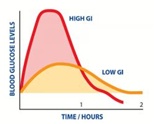
The Glycemic Index List of Foods & Values
The Glycemic Index List of Foods & Values
Some sugars, like the sugars that come from candy and starchy desserts, will raise your blood sugar level very quickly because your body begins breaking them down in your mouth, then the stomach, and are absorbed by small instestines. These sugars are often called refined sugars because the sugar has been processed. Foods with refined sugars in them are generally very sweet and will make you hungry for more food. They will also give you a quick burst of energy, leading to a sugar highthat is used by many athletes for energy during a competition.
However, other carbohydrates, such as those that come from whole wheat and grains, contain sugars that are called complex carbohydrates. Complex carbohydrates take longer to digest than refined sugars and, therefore, will help your blood sugar level rise slowly over a prolonged amount of time. Complex carbohydrates also have a tendency to have other nutritional values, such as fiber and vitamins; that will benefit your body by giving it more than just units of energy. Learn more about Sugars and Starches interactively.
Naturally, if you are a diabetic, then it is advantageous to eat foods that are plentiful in complex carbohydrates and eat less food that is made with refined sugars. Even so, many Diabetes researchers believe that a low-carbohydrate diet is the key to helping Diabetic patients control their diabetes.
How the Glycemic Index Works
Only 750 foods have been calculated to determine the Glycemic Index. There are a wide variety of publications that chart these Glycemic Index findings. These publications will help to map out which foods have how many carbohydrates and can help you form a nutritious diet based on how your body reacts to different types of carbohydrates.
The Glycemic Index is determined by a number of factors, including the amount of sugar in food, as well as the fiber and fat. Foods that have a higher number in the Glycemic Index are foods that will raise the blood sugar level faster than foods that have a lower number. Generally speaking, foods with refined sugars, such as desserts, have a higher number than complex carbohydrates. As such, those foods with higher numbers should be eaten in moderation or only in small portions when combined with nutritious foods.
The Glycemic Index also does not tell you how much of a particular serving is used to determine a particular number, glycemic load will tell you that. That’s because the Glycemic Index does not measure portions; it simply measures how quickly the food will turn into glucose. Glycemic Load (GL) is a ranking system for carb content of food portions based on their Glycemic Index and the portion size. Glycemic Load is a more accurate tool to tell you how many carbs you will eat and help you figure out how much insulin will be needed to cover the carb. From this information you can better calibrate your glucomonitor with the amount of sugar in your blood.
Remember, the Glycemic Index is a tool that you should be familiar with. Once you understand how different foods affect your body, you will be able to intelligently prepare your meals and snacks knowing how your food choices will affect your blood sugar level.
Here is an interactive module on diabetes which further explains the relationship between blood glucose control and the Glycemic Index.
Glycemic Index (G.I.) Chart
When reading the Glycemic Index, keep in mind that foods with a number greater than 70 are considered to be high. Foods with a calculation less than 55 are considered to be low.



